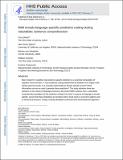| dc.contributor.author | Shain, Cory | |
| dc.contributor.author | Blank, Idan Asher | |
| dc.contributor.author | van Schijndel, Marten | |
| dc.contributor.author | Schuler, William | |
| dc.contributor.author | Fedorenko, Evelina | |
| dc.date.accessioned | 2021-11-23T14:43:08Z | |
| dc.date.available | 2021-11-23T14:43:08Z | |
| dc.date.issued | 2020 | |
| dc.identifier.uri | https://hdl.handle.net/1721.1/138209 | |
| dc.description.abstract | © 2019 Elsevier Ltd Much research in cognitive neuroscience supports prediction as a canonical computation of cognition across domains. Is such predictive coding implemented by feedback from higher-order domain-general circuits, or is it locally implemented in domain-specific circuits? What information sources are used to generate these predictions? This study addresses these two questions in the context of language processing. We present fMRI evidence from a naturalistic comprehension paradigm (1) that predictive coding in the brain's response to language is domain-specific, and (2) that these predictions are sensitive both to local word co-occurrence patterns and to hierarchical structure. Using a recently developed continuous-time deconvolutional regression technique that supports data-driven hemodynamic response function discovery from continuous BOLD signal fluctuations in response to naturalistic stimuli, we found effects of prediction measures in the language network but not in the domain-general multiple-demand network, which supports executive control processes and has been previously implicated in language comprehension. Moreover, within the language network, surface-level and structural prediction effects were separable. The predictability effects in the language network were substantial, with the model capturing over 37% of explainable variance on held-out data. These findings indicate that human sentence processing mechanisms generate predictions about upcoming words using cognitive processes that are sensitive to hierarchical structure and specialized for language processing, rather than via feedback from high-level executive control mechanisms. | en_US |
| dc.language.iso | en | |
| dc.publisher | Elsevier BV | en_US |
| dc.relation.isversionof | 10.1016/J.NEUROPSYCHOLOGIA.2019.107307 | en_US |
| dc.rights | Creative Commons Attribution-NonCommercial-NoDerivs License | en_US |
| dc.rights.uri | http://creativecommons.org/licenses/by-nc-nd/4.0/ | en_US |
| dc.source | PMC | en_US |
| dc.title | fMRI reveals language-specific predictive coding during naturalistic sentence comprehension | en_US |
| dc.type | Article | en_US |
| dc.identifier.citation | Shain, Cory, Blank, Idan Asher, van Schijndel, Marten, Schuler, William and Fedorenko, Evelina. 2020. "fMRI reveals language-specific predictive coding during naturalistic sentence comprehension." Neuropsychologia, 138. | |
| dc.contributor.department | Massachusetts Institute of Technology. Department of Brain and Cognitive Sciences | |
| dc.contributor.department | McGovern Institute for Brain Research at MIT | |
| dc.relation.journal | Neuropsychologia | en_US |
| dc.eprint.version | Author's final manuscript | en_US |
| dc.type.uri | http://purl.org/eprint/type/JournalArticle | en_US |
| eprint.status | http://purl.org/eprint/status/PeerReviewed | en_US |
| dc.date.updated | 2021-11-23T14:39:39Z | |
| dspace.orderedauthors | Shain, C; Blank, IA; van Schijndel, M; Schuler, W; Fedorenko, E | en_US |
| dspace.date.submission | 2021-11-23T14:39:40Z | |
| mit.journal.volume | 138 | en_US |
| mit.license | PUBLISHER_CC | |
| mit.metadata.status | Authority Work and Publication Information Needed | en_US |
